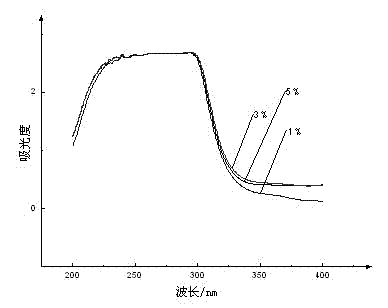Preparation method for Ag-Al co-doped p type ZnO film
A co-doping, p-type technology, applied in the field of chemistry and chemical engineering, can solve the problems that the p-n structure of the core components of semiconductor devices cannot be produced, the development and application of photoelectric components are limited, and it is difficult to realize p-type transformation, so as to achieve easy control, The effect of good appearance and low cost
- Summary
- Abstract
- Description
- Claims
- Application Information
AI Technical Summary
Problems solved by technology
Method used
Image
Examples
Embodiment 1
[0029] (1) Dissolve zinc acetate dihydrate in absolute ethanol to a concentration of 0.5mol / L, then add diethanolamine as a stabilizer according to the molar ratio of diethanolamine and zinc ions to 1:1, to obtain a mixed solution;
[0030] (2) Stir the mixed solution obtained in step (1) at 70°C for 30 minutes, and then press Ag + and A1 3+ accounted for Zn 2+ The mass percentage is 1% adding aluminum nitrate nonahydrate and silver nitrate, wherein Ag in aluminum nitrate nonahydrate and silver nitrate + : A1 3+ The mass ratio is 4:1, and stirring is continued for 45 minutes at 72°C;
[0031] (3) Aging the solution obtained in step (2) for 24 hours to make the solution form a sol;
[0032] (4) Clean the substrate material quartz glass with 30% hydrogen peroxide;
[0033] (5) Coating the sol obtained in step (3) on the cleaned substrate material in step (4) by using a spin coating method with a spin coating speed of 1000 rpm;
[0034] (6) Heat the coated substrate materia...
Embodiment 2
[0037] (1) Dissolve zinc acetate dihydrate in absolute ethanol to a concentration of 2mol / L, then add diethanolamine as a stabilizer according to the molar ratio of diethanolamine and zinc ions to 1:1, to obtain a mixed solution;
[0038] (2) Stir the mixed solution obtained in step (1) at 72°C for 40 minutes, and then press Ag + and A1 3+ accounted for Zn 2+ The mass percentage is 3% adding aluminum nitrate nonahydrate and silver nitrate, wherein Ag in aluminum nitrate nonahydrate and silver nitrate + : A1 3+ The mass ratio is 4:1, and stirring is continued for 30 minutes at 75°C;
[0039] (3) Aging the solution obtained in step (2) for 12 hours to make the solution form a sol;
[0040] (4) Clean the substrate material glass with 10% dilute hydrochloric acid;
[0041] (5) Coating the sol obtained in step (3) on the cleaned substrate material in step (4) by dipping and pulling at a pulling speed of 3 cm / min;
[0042] (6) Heat the coated substrate material obtained in step ...
Embodiment 3
[0045] (1) Dissolve zinc acetate dihydrate in absolute ethanol to a concentration of 1.5mol / L, then add diethanolamine as a stabilizer according to the molar ratio of diethanolamine and zinc ions to 1:1, to obtain a mixed solution;
[0046] (2) Stir the mixed solution obtained in step (1) at 75°C for 45 minutes, and then press Ag + and A1 3+ accounted for Zn 2+ The mass percentage is 5% adding aluminum nitrate nonahydrate and silver nitrate, wherein Ag in aluminum nitrate nonahydrate and silver nitrate + : A1 3+ The mass ratio is 4:1, and stirring is continued for 40 minutes at 70°C;
[0047] (3) Aging the solution obtained in step (2) for 20 hours to make the solution form a sol;
[0048] (4) Clean the substrate material quartz glass with 10% dilute sulfuric acid;
[0049] (5) Coating the sol obtained in step (3) on the cleaned substrate material in step (4) by using a spin coating method with a spin coating speed of 1600 rpm;
[0050] (6) Heat the coated substrate mate...
PUM
 Login to View More
Login to View More Abstract
Description
Claims
Application Information
 Login to View More
Login to View More - R&D
- Intellectual Property
- Life Sciences
- Materials
- Tech Scout
- Unparalleled Data Quality
- Higher Quality Content
- 60% Fewer Hallucinations
Browse by: Latest US Patents, China's latest patents, Technical Efficacy Thesaurus, Application Domain, Technology Topic, Popular Technical Reports.
© 2025 PatSnap. All rights reserved.Legal|Privacy policy|Modern Slavery Act Transparency Statement|Sitemap|About US| Contact US: help@patsnap.com

